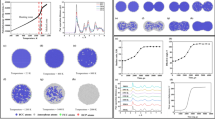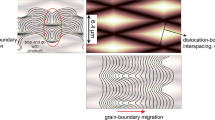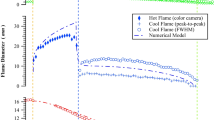Abstract
The size distribution and morphology of particles (dense or hollow) produced from polydispersed droplets in spray pyrolysis were studied both experimentally and theoretically. Zirconia, generated from a zirconyl hydroxychloride precursor, was selected as a model material. The simulation method that was previously developed by our group [J. Mater. Res., 15, 733 (2000)], in which droplets were assumed to be uniform, was improved to evaluate the effect of polydispersity in droplets on the size and morphology of the resulting particles. Simultaneous equations for heat and mass transfer of solvent evaporation and solute mass transfer inside droplets were solved numerically for a number of discrete classes of droplet size distribution. The role of the decomposition reaction was also included after the evaporation stage of polydispersed droplets in an attempt to explain the densification of particles. In hollow particle generation, this simulation was used to evaluate the thickness of a particle shell. The experimental results were in good agreement with the simulation data, suggesting that the model provides a more realistic prediction.









Similar content being viewed by others
References
Y. Xiong T.T. Kodas: Droplet evaporation and solute precipitation during spray pyrolysis. J. Aerosol Sci. 24, 893 1993
S.C. Zhang, G.L. Messing M. Borden: Synthesis of solid, spherical zirconia particles by spray pyrolysis. J. Am. Ceram. Soc. 73, 61 1990
I.W. Lenggoro, T. Hata, F. Iskandar, M.M. Lunden K. Okuyama: An experimental and modeling investigation of particle production by spray pyrolysis using a laminar flow aerosol reactor. J. Mater. Res. 15, 733 2000
K. Okuyama I.W. Lenggoro: Preparation of nanoparticles via spray route. Chem. Eng. Sci. 58, 537 2003
V. Jokanovic, B. Jokanovic, J. Nedeljkovic O. Milosevic: Modeling of nanostructured TiO2 spheres obtained by ultrasonic spray pyrolysis. Colloid Surf. A 249, 111 2004
G.V. Jayanthi, S.C. Zhang G.L. Messing: Modeling of solid particle formation during solution aerosol thermolysis: The evaporation stage. Aerosol Sci. Technol. 19, 478 1993
S. Nesic J. Vodnik: Kinetics of droplet evaporation. Chem. Eng. Sci. 46, 527 1991
T. Elperin B. Krasovitos: Evaporation of liquid droplets containing small solid particles. Int. J. Heat Mass Tran. 38, 2259 1995
G.L. Messing, S.C. Zhang G.V. Jayanthi: Ceramic powder synthesis by spray pyrolysis. J. Am. Ceram. Soc. 76, 2707 1993
S. Che, O. Sakurai, K. Shinozaki N. Mizutani: Particle structure control through intraparticle reactions by spray pyrolysis. J. Aerosol Sci. 29, 271 1998
G.A. Ferron, C. Roth, B. Busch E. Karg: Estimation of the size distribution of aerosols produced by jet nebulizers as a function of time. J. Aerosol Sci. 28, 805 1997
W.C. Hinds: Aerosol Technology: Properties, Behavior, and Measurement of Airborne Particles, 2nd ed. John Wiley & Sons, New York 1999), pp. 288, 286
C.C.M. Luijten, K.J. Bosschaart M.E.H. van Dongen: A new method for determining binary diffusion coefficients in dilute condensable vapors. Int. J. Heat Mass Tran. 40, 3497 1997
B.E. Poling, J.M. Prausnitz J.P. O’Connell: The Properties of Gases and Liquids, 5th ed. Mc. Graw-Hill Inc., New York 2001), pp. A.45, 9.75
J. Sloth, S. Kiil, A.D. Jensen, S.K. Andersen, K. Jorgensen, H. Schiffter G. Lee: Model based analysis of the drying of a single solution droplet in an ultrasonic levitator. Chem. Eng. Sci. 61, 2701 2006
S. Deguchi, H. Matsuda, M. Hasatani N. Kobayashi: Formation mechanism of TiO2 fine particles prepared by the spray pyrolysis method. Dry. Technol. 12, 577 1994
H-F. Yu: Simulation of spray pyrolysis for ceramic powder preparation. Particul. Sci. Technol. 13, 149 1995
D.B. Williams C.B. Carter: Transmission Electron Microscopy: A Textbook for Materials Science Springer Science Business Media, New York 1996 30
T.T. Kodas M.J. Hampden-Smith: Aerosol Processing of Materials Wiley-VCH., Canada 1999 387
Z.Z. Yuan, X.D. Chen, B.X. Wang Y.J. Wang: Kinetics study on non-isothermal crystallization of the metallic Co43Fe20Ta5.5B31.5 glass. J. Alloy Compd. 407, 163 2006
M.N. Rahaman: Ceramic Processing and Sintering, 2nd ed. Marcel Dekker, New York 2003), p. 68
H.E. Kissinger: Reaction kinetics in differential thermal analysis. Anal. Chem. 29, 1702 1957
ACKNOWLEDGMENTS
The authors wish to thank Shunsuke Kinouchi for droplet size distribution measurement, Takashi Ogi for TEM analysis, and Nippon Light Metal, Shizuoka, Japan, for providing zirconyl hydroxychloride solution. The Ministry of Education, Culture, Sports, Science and Technology (MEXT) of Japan and the Japan Society for the Promotion of Science (JSPS) are acknowledged for providing a doctoral scholarship (W. Widiyastuti) and a postdoctoral fellowship (W.N. Wang), respectively. Grants-in-aid sponsored by MEXT and JSPS are acknowledged (K. Okuyama, I.W. Lenggoro).
Author information
Authors and Affiliations
Corresponding author
Appendix
Appendix
The activation energy for decomposition reaction can be calculated from the Arrhenius kinetic reaction equation:

where θ is the heating rate, TR is the decomposition temperature, Ea is the activation energy for the decomposition reaction, A is the pre-exponential factor, and R is the gas constant. By using the least-squares statistical method, the activation energy can be obtained. By plotting −ln(θ/T2R) versus 1/TR for six selected heating rates it is possible to ascertain the values of Ea and A from the gradient and intercept, respectively, as shown in Fig. A1. The values from this correlation were 159.77 kJ mol−1 and 9.67 × 1012 min−1, respectively.
Three theoretical kinetic equations describing decomposition/crystallization mechanisms were examined. The models correspond to the ordinary kinetics of chemical reactions reflecting different assumptions for nucleation and crystal growth.20, 21 Normal grain growth, Johnson–Mehl–Avrami, and three-dimensional diffusion models tend to be influenced by the reaction order, nucleation controlling reaction, and a diffusion controlling reaction, respectively.
The reaction order (n) determined by Kissinger,22 was solved by the nonlinear equation in Eq. (A3) using Microsoft Excel. The value of the reaction order was calculated to be 1.25, not influenced significantly by the decomposition temperature of the selected heating rate.

S, α, and β are the analytical parameters derived by Kissinger, which are only a function of the reaction order. ln[k(T)f(xR)] versus −ln(1 − xR) for each model was compared with experimental data taken from TG-DTA. Of the three models, the normal grain growth (NGG) showed the best fit, indicating that the NGG reaction mechanism adequately describes the formation of zirconia from the zirconyl hydroxychloride precursor, as shown in Fig. A2.
Rights and permissions
About this article
Cite this article
Widiyastuti, W., Wang, WN., Lenggoro, I.W. et al. Simulation and experimental study of spray pyrolysis of polydispersed droplets. Journal of Materials Research 22, 1888–1898 (2007). https://doi.org/10.1557/jmr.2007.0235
Received:
Accepted:
Published:
Issue Date:
DOI: https://doi.org/10.1557/jmr.2007.0235






